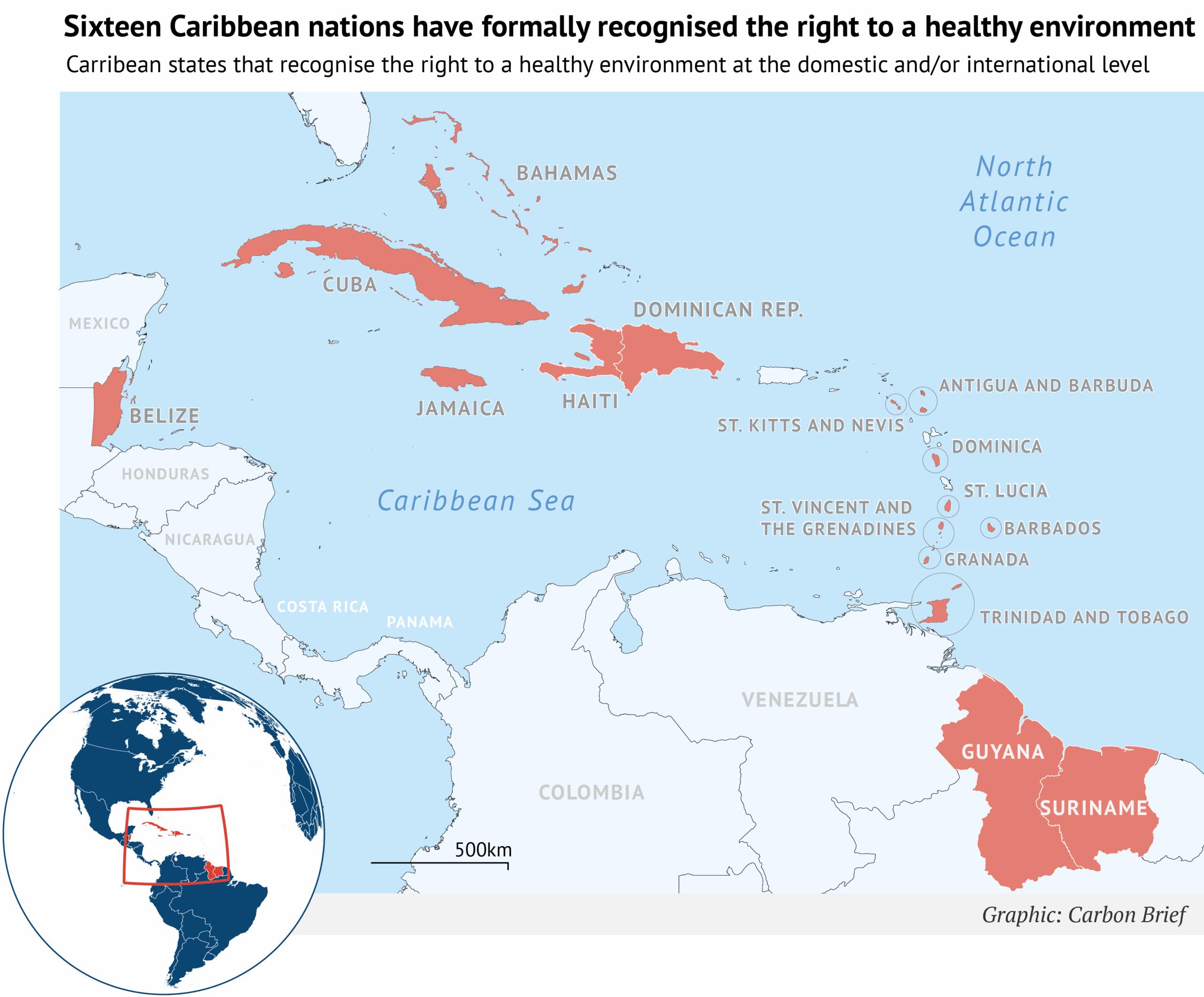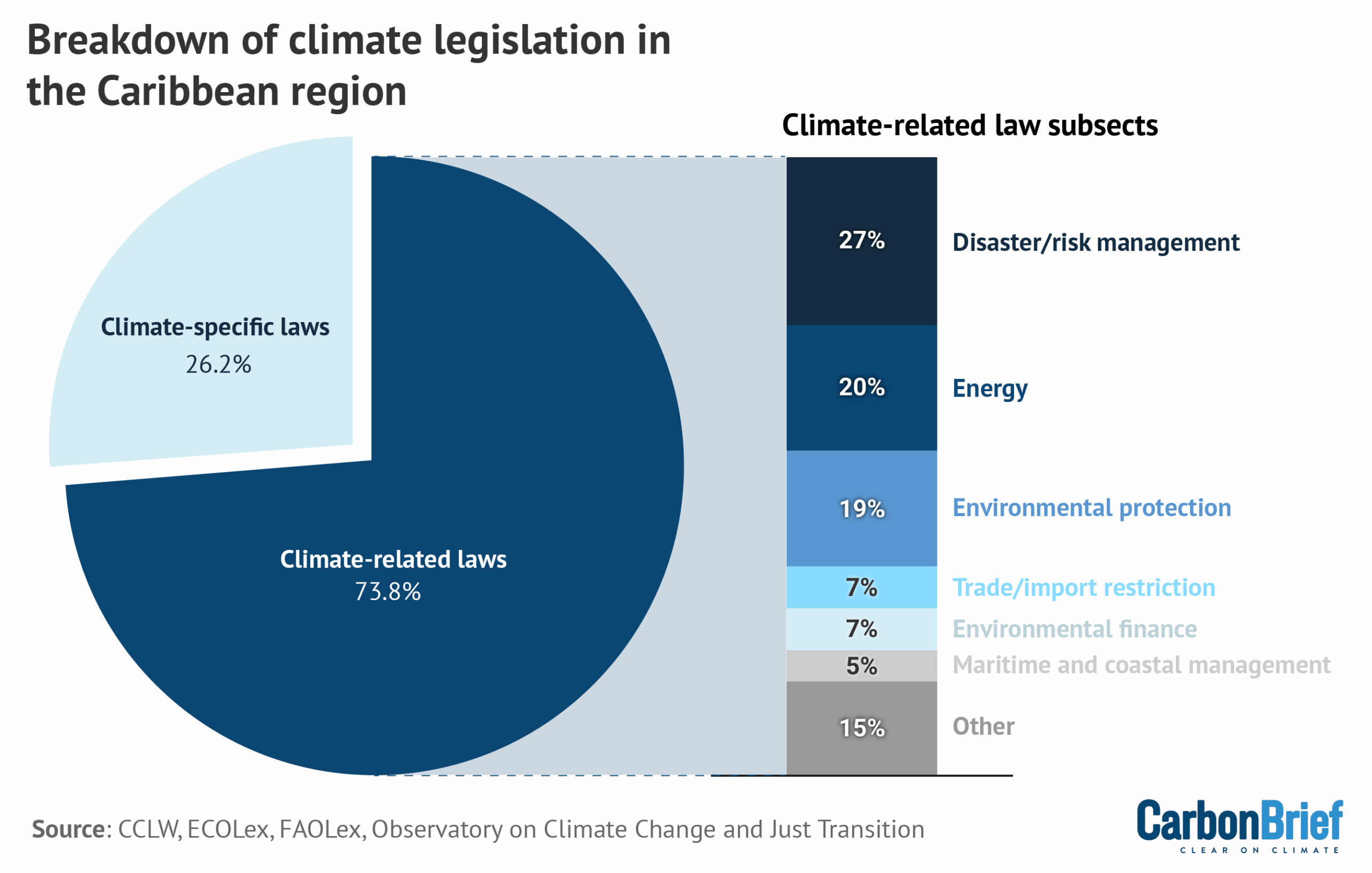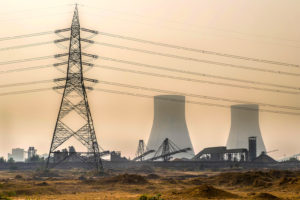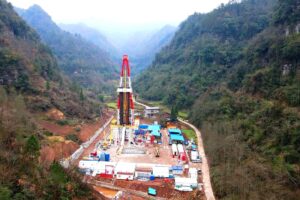Welcome to Carbon Brief’s DeBriefed.
An essential guide to the week’s key developments relating to climate change.
This week
Renewables overtake coal
‘HISTORIC FIRST’: Renewables have overtaken coal to become the world’s leading source of electricity for the first six months of this year in a “historic first”, BBC News said. The analysis, from the thinktank Ember, found the world generated “almost a third” more solar power in the first half of the year, compared with the same period in 2024, while wind power grew by “just over 7%,” reported the Guardian.
HEAVY LIFTING: According to the report, China and India were “largely responsible for the surge in renewables”, while the US and Europe “relied more heavily on fossil fuels,” the Guardian wrote. China built more renewables than every other country combined in the first half of this year, the newspaper added.
CONTINENTAL SHIFTS: A second report from the International Energy Agency (IEA) predicted a “surge” in global wind and solar capacity by 2030, but shaved 5% off its previous forecast, the Financial Times said. The IEA revealed that India is set to become the second-largest growth market for renewables after China, “with capacity expected to increase 2.5 times by 2030”, Down to Earth reported. The IEA also upped its forecast for renewables in the Middle East and north Africa by 23%, “helped by Saudi Arabia rolling out wind turbines and solar panels”, but halved the outlook for the US, the FT noted.
Around the world
- EV BOOM: Sales of electric and hybrid cars made up “more than half” of all new car registrations in the UK last month, a new record, according to data from the Society of Motor Manufacturers, reported BBC News.
- BANKING COLLAPSE: A global banking alliance launched by the UN to get banks to slash the carbon footprint of their loans and investments and help drive the transition to a net-zero economy by 2050 has collapsed after four years, Agence France-Press reported.
- CUTS, CUTS, CUTS: The Trump administration plans to cut nearly $24bn in funding for more than 600 climate projects across the US, according to documents reviewed by the Wall Street Journal.
- PEOPLE POWER: A farmer, a prison guard and a teacher were among those from the Dutch-Caribbean island Bonaire who appeared at the Hague on Tuesday to “accuse the Netherlands of not doing enough to protect them from the effects of climate change”, Politico reported.
400,000
The number of annual service days logged by the US National Guard responding to hurricanes, wildfires and other natural disasters over the past decade, according to a Pentagon report to Congress, Inside Climate News reported.
Latest climate research
- Politicians in the UK “overwhelmingly overestimate the time period humanity has left to bend the temperature curve”, according to a survey of 100 MPs | Nature Communications Earth and Environment
- Fire-driven degradation of the Amazon last year released nearly 800m tonnes of CO2 equivalent, surpassing emissions from deforestation and marking the “worst Amazon forest disturbance in over two decades” | Biogeosciences
- Some 43% of the 200 most damaging wildfires recorded over 1980-2023 occurred in the last decade | Science
(For more, see Carbon Brief’s in-depth daily summaries of the top climate news stories on Monday, Tuesday, Wednesday, Thursday and Friday.)
Captured

The UK’s Climate Change Act, landmark legislation that guides the nation’s response to climate change, is increasingly coming under attack from anti-net-zero right-leaning politicians. In a factcheck published this week, Carbon Brief explained how the UK’s Climate Change Act was among the first comprehensive national climate laws in the world and the first to include legally binding emissions targets. In total, 69 countries have now passed “framework” climate laws similar to the UK’s Climate Change Act, with laws in New Zealand, Canada and Nigeria among those explicitly based on the UK model. This is up from just four when the act was legislated in 2008. Of these, 14 are explicitly titled the “Climate Change Act”.
Spotlight
Fukushima’s solar future
This week, Carbon Brief examines how Fukushima helped to recover from nuclear disaster by building solar farms on contaminated farmland.
On 11 March 2011, an earthquake off the pacific coast of Japan caused 15m-tall waves to crash into the eastern region of Tōhoku, killing 19,500 people and injuring a further 6,000.
In the aftermath, flooding at the Fukushima Daichi nuclear power plant caused cooling systems to fail, leaching radioactive contaminants into the soil and leading to a major nuclear incident.
Some 1,200km2 around the site was restricted and up to 100,000 people were evacuated – in some cases forever.
In the years following, Japan entered a fraught debate about nuclear energy.
In 2010, nuclear power provided 25% of Japan’s electricity, but, in the years following the disaster, its 54 nuclear reactors were taken offline.
Successive governments have fought over reintroducing nuclear power. Today, some 14 reactors are back online, 27 have been permanently closed and another 19 remain suspended. (Japan’s newly-elected prime minister Sanae Takaichi has promised to make nuclear central to her energy strategy.)
Against this backdrop, Fukushima – a prefecture home to 1.8 million people – has emerged as a surprise leader in the renewables race.
In 2014, the Fukushima Renewable Energy Institute (FREA) opened with the twin goals of promoting research and development into renewable energy, while “making a contribution to industrial clusters and reconstruction”.
That same year, the prefecture declared a target of 100% renewable power by 2040.
Contaminated land
“A lot of these communities, I know, were looking for ways to revitalise their economy,” said Dr Jennifer Sklarew, assistant professor of energy and sustainability at George Mason University and author of “Building Resilient Energy Systems: Lessons from Japan”.
Once evacuation orders were lifted, however, residents in many parts of Fukushima were faced with a dilemma, explained Skarlew:
“Since that area was largely agricultural, and the agriculture was facing challenges due to stigma, and also due to the soil being removed [as part of the decontamination efforts], they had to find something else.”
One solution came in the form of rent, paid to farmers by companies, to use their land as solar farms.
Michiyo Miyamoto, energy finance specialist at the Institute for Energy Economics and Financial Analysis, told Carbon Brief:
“The [Fukushima] prefecture mapped suitable sites early and conducted systematic consultations with residents and agricultural groups before projects were proposed. This upfront process reduced land-use conflicts, shortened permitting timelines and gave developers clarity.”
As a result, large-scale solar capacity in Fukushima increased to more than 1,300 megawatts (MW) from 2012 to 2023, according to Miyamoto. Moreover, installed renewable capacity now exceeds local demand, meaning the region can run entirely on clean power when conditions are favourable, Miyamoto said.
Today, aerial pictures of Fukushima reveal how solar panels have proliferated on farmland that was contaminated in the nuclear disaster.

Charging on
Last year, 60% of Fukushima’s electricity was met by renewables, up from 22% in 2011. (The country as a whole still lags behind at 27%.)
And that is set to grow after Japan’s largest onshore windfarm started operations earlier this year in Abukuma, Fukushima, with a capacity of 147MW.
The growth of solar and wind means that Fukushima is already “ahead of schedule” for its 2040 target of 100% renewable power, said Miyamoto:
“The result is a credible pathway from recovery to leadership, with policy, infrastructure and targets working in concert.”
Watch, read, listen
OVERSHOOT: The Strategic Climate Risks Initiative, in partnership with Planet B Productions, has released a four-part podcast series exploring what will happen if global warming exceeds 1.5C.
DRONE WARFARE: On Substack, veteran climate campaigner and author Bill McKibben considered the resilience of solar power amid modern warfare.
CLIMATE AND EMPIRE: For Black history month, the Energy Revolution podcast looked at how “race and the legacies of empire continue to impact the energy transition”.
Coming up
- 12 October: presidential elections, Cameroon
- 13-14 October: Pre-COP, Brasilia, Brazil
- 13-18 October: World Bank Group/IMF annual meetings, Washington DC
- 14-17 October: 2nd extraordinary session of the Marine Environment Protection Committee at the International Maritime Organisation, London
- 15-16 October: Circle of Finance Ministers report
Pick of the jobs
- Buckinghamshire Council, principal climate change officer | Salary: £49,354-£51,759. Location: Aylesbury, Buckinghamshire
- Sustainable NI, sustainable business lead | Salary: £60,000. Location: Belfast, Northern Ireland
- Dialogue Earth, South Asia managing editor | Salary: £1,875 per month. Location: South Asia
DeBriefed is edited by Daisy Dunne. Please send any tips or feedback to debriefed@carbonbrief.org.
This is an online version of Carbon Brief’s weekly DeBriefed email newsletter. Subscribe for free here.
The post DeBriefed 10 October 2025: Renewables power past coal; Legacy of UK’s Climate Change Act; Fukushima’s solar future appeared first on Carbon Brief.
Greenhouse Gases
Guest post: How Caribbean states are shifting climate legislation
The Caribbean region is among the most vulnerable to climate change, despite historically contributing less than half of one percent of global greenhouse gas emissions.
Rising sea levels, extreme heat and more frequent and intense storms – such as the 2024 Hurricane Beryl, which made landfall in Grenada – pose urgent and growing threats to the small island states, coastal nations and overseas territories that comprise the Caribbean region.
With global progress to address climate change still too slow, Caribbean countries are taking matters into their own hands by enacting more robust legislation to help protect against climate risks.
In a new study published in the Carbon and Climate Law Review, we identified 78 climate laws and legally binding decrees across 16 Caribbean states, as well as two constitutional references to climate change and a growing recognition of the right to a healthy environment.
Our analysis suggests that, together, these developments are not only enhancing resilience, but also positioning Caribbean states as influential actors in the global climate arena.
Caribbean climate laws on the rise
Climate governance in the Caribbean has expanded significantly in recent years. In the past decade, countries such as Cuba and the Dominican Republic have embedded climate obligations and programmatic guidelines into their national constitutions.
At the same time, legislative recognition of the human right to a healthy environment is gaining momentum across the region. Six Caribbean nations now affirm the right in their constitutions, while 15 have recognised it through international instruments, such as the UN Council, UN Assembly and the Escazu Agreement, as shown in the figure below.

More recently, there has been a notable rise in targeted, sector-specific climate frameworks that go beyond broader environmental statutes.
Saint Lucia stands out as the only country with a climate framework law, or a comprehensive national law that outlines long-term climate strategies across multiple domains. Meanwhile, several other Caribbean governments have adopted climate-specific laws that focus on individual sectors, such as energy, migration and disaster management.
According to our analysis, more than a quarter of climate-relevant legislation in the region – comprising 21 laws and legally binding decrees – now has an explicit focus on climate change, as illustrated in the chart below.
Our research suggests that this represents an ongoing shift in legislative focus, reflecting changes in how climate legislation is being structured in one of the world’s most climate-vulnerable regions.

Caribbean nations are also advancing legal reforms to structure and institutionalise climate finance and market mechanisms directly into domestic law, aligned with Article 6.2 of the Paris Agreement.
For example, the Bahamas has introduced provisions for carbon credit trading, while Antigua and Barbuda, Barbados and Grenada have established national climate financing mechanisms to support mitigation and adaptation efforts.
Some states, including Belize and Saint Kitts and Nevis, have incorporated regional bodies such as the Caribbean Community Climate Change Centre – the climate arm of the intergovernmental Caribbean community organisation CARICOM – into national frameworks. This indicates an increasing alignment between regional cooperation and domestic law.
In addition to the influx of regulations specifically addressing climate change, Caribbean nations are also legislating broader environmental issues, which, in turn, could provide increased resilience from climate impacts and risks, as shown in the graph above.
Key trends in these types of climate-related laws include the expansion of disaster risk management governance, which addresses national preparedness for climate-induced weather events or related catastrophes. Likewise, energy law is an increasingly prominent focus, with countries including Antigua and Barbuda and Saint Vincent and the Grenadines integrating renewable energy and energy efficiency goals into national climate governance.
More broadly, many Caribbean nations have adopted wide-ranging and comprehensive environmental laws, many of which were developed in alignment with existing climate commitments. In combination, these legal developments reflect a dynamic and evolving climate governance landscape across the region.
Proactive vs reactive approaches
Despite general alignment with these broader regional trends, our research reveals distinct developmental pathways shaping domestic climate regulation.
In the eastern Caribbean, for example, we saw both proactive, long-term planning strategies and reactive, post-disaster reforms.
Saint Lucia’s multifaceted approach to climate resilience evolved steadily over the course of more than a decade. During this time, the country developed numerous adaptation plans, strengthened cross-sectoral coordination and engaged in institutional climate reforms in areas such as energy, tourism, finance and development.
More recently, the passage of Saint Lucia’s Climate Change Act in 2024 marked a milestone in climate governance, by giving legal force to the country’s obligations under the UNFCCC, the Kyoto Protocol and the Paris Agreement – making Saint Lucia one of the few small island states to incorporate global climate commitments into domestic law.
Our research indicates that this strategy has not only positioned the country as a more climate-resilient nation, but also solidified its access to international climate financing.
In contrast, Dominica’s efforts evolved more rapidly in the aftermath of Hurricane Maria in 2017, which destroyed over 200% of the country’s GDP. The storm’s impacts were felt across the country and hit particularly hard for the Kalinago people – the Caribbean’s last Indigenous community – highlighting the role of socioeconomic disparities in shaping climate vulnerability and resilience.
In response, the government passed the Climate Resilience Act, creating the temporary Climate Resilience Execution Agency for Dominica (CREAD).
Beyond establishing an exclusively climate-focused institution, the act aimed to embed resilience into governance by mandating the participation of vulnerable communities – including Indigenous peoples, women, older people and people with disabilities – in shaping and monitoring climate resilience projects.

As noted in a recent statement by the UN special rapporteur on Climate Change, Dr Elisa Morgera, these frameworks underscore the government’s ambition to become the world’s first “climate-resilient nation.”
Although challenges persist, Dominica’s efforts demonstrate how post-disaster urgency can drive institutional change, including the integration of rights and resilience into climate governance.
Uneven progress and structural gaps
Despite significant progress, our research shows that several key opportunities for climate governance across the Caribbean continue to exist, which could enable improvements in both resilience and long-term ambition.
The region’s legal landscape remains somewhat heterogeneous. While Saint Lucia has enacted a comprehensive climate framework law, the rest of the region lacks similar blanket legislation. This includes some states that entirely lack climate-specific laws, instead relying on related laws and frameworks to regulate and respond to climate-related risks.
Other nations have yet to adopt explicit disaster-risk management frameworks, leaving Caribbean populations vulnerable before, during and after climate emergencies. Most have yet to enshrine the right to a healthy environment at the national level.
Our research suggests that outdated legal frameworks are further limiting progress in addressing current climate risks. Because many of the longer-standing environmental laws in the region were adopted well before climate policy became a mainstream concern, some fail to address the nature, frequency and intensity of modern climate challenges, such as sea-level rise, tropical storms, wildfires, floods, droughts and other impacts.
More broadly, many Caribbean climate laws include limited integration of gender equity, Indigenous rights and social justice. As Caribbean nations such as Grenada and the Dominican Republic begin to link climate resilience with these issues, the region has an opportunity to lead by example.
Ultimately, capacity and resource constraints persist as significant barriers to implementation and adaptation.
The Caribbean region faces debt that exacerbates ongoing development challenges, a burden made heavier by the repeated economic shocks of climate-related disasters. Along with regional debt-for-resilience schemes, increased funding from high-emitting countries to support adaptation measures in climate-vulnerable nations – as endorsed under the Paris Agreement – is likely to be critical to ensuring the region’s climate laws can be executed effectively.
Global implications of Caribbean climate law
Our research suggests that Caribbean countries are outpacing other regions in terms of the scope and ambition of their climate laws. This legislation has the potential to serve as a model for climate-vulnerable nations worldwide.
Continuing efforts in the region show that legal frameworks in the field can not only drive resilience, embed rights and strengthen claims to international finance, but also highlight how regional cooperation and diplomacy can enhance global influence.
These findings demonstrate that innovation in climate law need not wait for action from major emitters, but can instead be led by those on the front lines of climate change.
The post Guest post: How Caribbean states are shifting climate legislation appeared first on Carbon Brief.
Guest post: How Caribbean states are shifting climate legislation
Greenhouse Gases
IEA: Renewables have cut fossil-fuel imports for more than 100 countries
More than 100 countries have cut their dependence on fossil-fuel imports and saved hundreds of billions of dollars by continuing to invest in renewables, according to the International Energy Agency (IEA).
It says nations such as the UK, Germany and Chile have reduced their need for imported coal and gas by around a third since 2010, mainly by building wind and solar power.
Denmark has cut its reliance on fossil-fuel imports by nearly half over the same period.
Renewable expansion allowed these nations to collectively avoid importing 700m tonnes of coal and 400bn cubic metres of gas in 2023, equivalent to around 10% of global consumption.
In doing so, the fuel-importing countries saved more than $1.3tn between 2010 and 2023 that would otherwise have been spent on fossil fuels from overseas.
Reduced reliance
The IEA’s Renewables 2025 report quantifies the benefits of renewable-energy deployment for electricity systems in fossil fuel-importing nations.
It compares recent trends in renewable expansion to an alternative “low renewable-energy source” scenario, in which this growth did not take place.
In this counterfactual, fuel-importing countries stopped building wind, solar and other non-hydropower renewable-energy projects after 2010.
In reality, the world added around 2,500 gigawatts (GW) of such projects between 2010 and 2023, according to the IEA, more than the combined electricity generating capacity of the EU and US in 2023, from all sources. Roughly 80% of this new renewable capacity was built in nations that rely on coal and gas imports to generate electricity.
The chart below shows how 31 of these countries have substantially cut their dependence on imported fossil fuels over the 13-year period, as a result of expanding their wind, solar and other renewable energy supplies. All of these countries are net importers of coal and gas.

In total, the IEA identified 107 countries that had reduced their dependence on fossil fuel imports for electricity generation, to some extent due to the deployment of renewables other than hydropower.
Of these, 38 had cut their reliance on electricity from imported coal and gas by more than 10 percentage points and eight had seen that share drop by more than 30 percentage points.
Security and resilience
The IEA stresses that renewables “inherently strengthen energy supply security”, because they generate electricity domestically, while also “improving…economic resilience” in fossil-fuel importer countries.
This is particularly true for countries with low or dwindling domestic energy resources.
The agency cites the energy crisis exacerbated by Russia’s invasion of Ukraine, which exposed EU importers to spiralling fossil-fuel prices.
Bulgaria, Romania and Finland – which have historically depended on Russian gas for electricity generation – have all brought their import reliance close to zero in recent years by building renewables.
In the UK, where there has been mounting opposition to renewables from right-wing political parties, the IEA says reliance on electricity generated with imported fossil fuels has dropped from 45% to under 25% in a decade, thanks primarily to the growth of wind and solar power.
Without these technologies, the UK would now be needing to import fossil fuels to supply nearly 60% of its electricity, the IEA says.
Other major economies, notably China and the EU, would also have had to rely on a growing share of coal and gas from overseas, if they had not expanded renewables.
As well as increasing the need for fossil-fuel imports from other countries, switching renewables for fossil fuels would require significantly higher energy usage “due to [fossil fuels’] lower conversion efficiencies”, the IEA notes. Each gigawatt-hour (GWh) of renewable power produced has avoided the need for 2-3GWh of fossil fuels, it explains.
Finally, the IEA points out that spending on renewables rather than imported fossil fuels keeps more investment in domestic economies and supports local jobs.
The post IEA: Renewables have cut fossil-fuel imports for more than 100 countries appeared first on Carbon Brief.
IEA: Renewables have cut fossil-fuel imports for more than 100 countries
Greenhouse Gases
Cropped 8 October 2025: US government shutdown; EU loses green space; Migratory species extinction threat
We handpick and explain the most important stories at the intersection of climate, land, food and nature over the past fortnight.
This is an online version of Carbon Brief’s fortnightly Cropped email newsletter. Subscribe for free here.
Key developments
Forest fund delays and cuts
TFFF BEHIND SCHEDULE: Brazil’s flagship forest fund, the Tropical Forest Forever Facility (TFFF), is “running behind schedule as officials deliberate on how to structure the complex financial vehicle” in time for COP30, Bloomberg reported. The “ambitious” fund aims to raise $125bn to help countries protect rainforests “using investment returns from high-yielding fixed-income assets”, it explained. However, the outlet reported that investor events have either not been held or cancelled, while officials are still mulling “possible structures” for the fund.
CUTS DEEP: Environmentalists fear that “sweeping spending cuts for forest protection” by Argentina’s “pro-business libertarian” president, Javier Milei, could endanger the country’s forests, Climate Home News reported. The impacts of these cuts are “already becoming evident”, contributing to deforestation – particularly in the northern Gran Chaco region, environmentalists told the outlet. According to Argentine government data, the country lost about 254,000 hectares of forest nationwide in 2024. Milei – who has said he wants to withdraw Argentina from the Paris Agreement – faces a “crucial midterm election” in October that could make environmental deregulation even easier, the outlet wrote.
BANKING ON THE AMAZON: A new report found that 298 banks around the world “channelled $138.5bn” to companies developing new fossil-fuel projects in Latin America and the Caribbean, Mongabay reported. The experts behind the study told the outlet: “Some major banks have adopted policies to protect the Amazon, but these have had little impact, as they do not apply to corporate-level financing for oil and gas companies operating in the Amazon.” Mongabay approached every bank, but only JPMorgan Chase responded, declining to comment.
-
Sign up to Carbon Brief’s free “Cropped” email newsletter. A fortnightly digest of food, land and nature news and views. Sent to your inbox every other Wednesday.
‘Green to grey’
‘600 FOOTBALL PITCHES’: Europe is losing “green space…at the rate of 600 football pitches a day”, according to a new, cross-border investigation by the “Green to Grey Project”, the Guardian reported. The outlet – part of the Arena for Journalism in Europe collaboration of journalists and scientists behind the project – added that Turkey accounted for more than a fifth of the total loss in Europe. While nature “accounts for the majority of the losses”, the research showed that the EU is also rapidly building on agricultural land, “with grave consequences for the continent’s food security and health”, it continued.
‘TWICE AS HIGH’: Conducted by 40 journalists and scientists from 11 countries, the investigation found that the “natural area” lost to construction in the EU was “twice as high as official estimates”, Le Monde reported. Despite Brussels setting a 2011 target to “reduce the EU’s yearly land take” to 800km2 – “more than 100,000 football fields” – the EU is “artificialising more than 1,000km2 of land per year”, it added.
KEY DRIVERS: While the “main drivers of land loss across Europe” are housing and road-building, Arena for Journalism in Europe found many instances of construction “that serve only a minority or that are not built based on public need”, such as luxury tourism sites. Between 2018 to 2023, “an area the size of Cyprus” in nature and cropland was lost to construction, they added. Researchers who “scrutinised millions of pixels in search of lost natural areas” found that Finland’s tourism boom is “encroaching on the last remaining sanctuaries” in Lapland, another Le Monde story reported.
News and views
‘INTRACTABLE’ OFFSETS: A new review paper found that the failure of carbon offsets to cut emissions is “not due to a few bad apples”, but “down to deep-seated systemic problems that incremental change will not solve”, the Guardian wrote. Study co-author Dr Stephen Lezak told the outlet: “We have assessed 25 years of evidence and almost everything up until this point has failed.” The worst of these “intractable problems” were with “issuing additional credits” for “non-additional”, “impermanent” and double-counted projects, the Guardian noted.
INSTITUTIONALISING AGROECOLOGY: The Cuban government issued a national decree providing a “more explicit legal framework” for the implementation of agroecological principles across the country, according to a release from the Caribbean Agroecology Institute. The decree also announced a new national fund for promoting agroecology. Yamilé Lamothe Crespo, the country’s deputy director of science, innovation and agriculture, “emphasised that agroecology is a model capable of responding to the global climate crisis”, teleSUR reported.
ZERO PROGRESS TO ZERO HUNGER: The world has “made no improvement” towards achieving the “zero hunger” Sustainable Development Goal since it was set in 2015, according to a new report from the UN Food and Agriculture Organization. The report said that “ongoing geopolitical tensions and weather-related disruptions” have contributed to “continued instability in global food markets”. Separately, a new report from the Energy and Climate Intelligence Unit thinktank estimated that a “year’s worth of bread” has been lost in the UK since 2020 due to extreme weather impacting wheat harvests, the Guardian reported.
MEATLESS MEDIA: More than 96% of analysed climate news stories across 11 (primarily US-based) outlets “made no mention of meat or livestock production as a cause of climate change”, according to analysis by Sentient Media. Sentient, a not-for-profit news organisation in the US, looked at 940 stories to assess the reported causes of greenhouse gas emissions. Around half of the stories included mention of fossil fuels, it said. Covering the report, the Guardian wrote: “The data reveals a media environment that obscures a key driver of the climate crisis.”
FRAUGHT PATH: One-fifth of migratory species “face extinction from climate change”, according to a new report by the UN’s migratory species convention, covered by Carbon Copy. The “warning” comes as climate change and extreme weather are “altering their ranges [and] shrinking habitats”, the Mail & Guardian wrote. Oceanographic Magazine noted that the North Atlantic right whale is “forced to make migratory detours into dangerous pockets of the ocean” due to warming seas. Down to Earth reported that the range of Asian elephants is “shifting east” in “response to anthropogenic land-use and climate change”.
GOODBYE, GOODALL: Dr Jane Goodall, the groundbreaking English primatologist, died at the age of 91 last week. BBC News noted that Goodall “revolutionised our understanding” of chimpanzees, our “closest primate cousins. The outlet added that she “never wavered in her mission to help the animals to which she dedicated her life”. CNBC News reported that Goodall followed a vegan diet due to factory farming and the “damage done to the environment by meat production”. She also “encouraged” others to follow her example, the outlet said.
Spotlight
What the US government shutdown means for food, forests and climate
This week, Carbon Brief explains the US government shutdown – now in its second week – and its implications for food, forests, public lands and climate change.
The US federal government shut down at 12:01 eastern daylight time on 1 October, as Congress failed to agree on a bill to keep funding the government and its services.
This is the 11th time that the government has shut down in such a fashion; previous shutdowns have lasted anywhere from a few hours to longer than a month.
As a result of the shutdown, 750,000 federal employees have been furloughed, or placed on unpaid leave. Others, whose work has been deemed “essential”, are working without pay.
(A law passed during a shutdown in US president Donald Trump’s first term guarantees back pay and benefit accrual for furloughed employees. However, the White House has argued that the law does not necessarily guarantee these benefits.)
Some agencies have seen close to 90% of their employees furloughed.
With a reopening date uncertain, Carbon Brief explored what the shutdown means for food, forests and climate.
Food and farming
According to the agency’s “lapse of funding” plan, the US Department of Agriculture (USDA) planned to furlough about half of its employees for the duration of the shutdown.
Among the activities put on hold during the funding lapse are the disbursement of disaster-assistance payments for farmers impacted by extreme weather events. The Farm Service Agency, which oversees these payments, will also not process any new loans during the shutdown, such as those that provide assistance to farmers during the harvest.
The Natural Resources Conservation Service, an arm of the USDA with a mission to help private landowners “restore, enhance and protect forestland resources”, has seen more than 95% of its staff furloughed, effectively halting all conservation efforts within the agency.
Certain animal-health programmes – such as the one addressing the highly pathogenic avian influenza outbreak – will continue, but others will shutter for the duration of the funding lapse. Long-term research on animal and plant diseases will also cease.
Forests and fires
The US Forest Service falls under the purview of the USDA. Employees responsible for “responding [to] and preparing for wildland fires” will continue to work during the shutdown; however, “hazardous fuels treatments” – such as prescribed burns or pruning to reduce fuel loads – will be reduced under the agency’s plan. Furthermore, state grants for fire preparedness and forest management “may be delayed”.
Work on forest restoration projects may potentially continue “on a case-by-case basis”, the plan said.
The Bureau of Land Management (BLM), a subdivision of the Department of the Interior, will furlough around 43% of its employees, according to its contingency plan. Staff dedicated to fire management will continue to work while “carryover balances” are available, but the number of staff working will be reduced once these funds are exhausted.
Climate change and research
Across the federal government, most research activities are being put on hold, including conference travel and the issuing of new grants.
Grant recipients may continue carrying out research “to the extent that doing so will not require federal staff” and while funds are available, according to the National Science Foundation’s operational plan. This does not include researchers at federal agencies, such as the Environmental Protection Agency, US Geological Survey and the National Oceanic and Atmospheric Administration (NOAA).
The funding-lapse plan set out by the Department of Commerce said that NOAA will continue its prediction and forecasting activities, as well as maintain “critical and mission-related” programmes related to research satellites. However, “most research activities” will cease.
Similarly, NASA’s shutdown plan indicates continuing support for satellite operations, but a pause on research activities – except for those “aligned with presidential priorities”.
Watch, read, listen
MORAINE DILEMMA: A new PBS documentary walked through ancient Inca paths in the Andes to understand how modern communities are confronting the loss of Peru’s glaciers.
SUBSIDISING ‘EXPLOITATION’: A DeSmog investigation revealed how farmers convicted of “exploiting migrant workers” continue to claim “millions in taxpayer-funded subsidies”.
GROUND TRUTHING: A podcast from the Hindu looked back at 20 years of India’s Forest Rights Act, meant to “address historic injustices” towards the country’s Indigenous communities.
DEEP DIVE MANUAL: Mongabay journalists shared how they investigated Brazil’s shark-meat purchases that were subsequently served in schools, prisons and hospitals.
New science
- The frequency of “economically disastrous” wildfires increased sharply after 2015, with the highest disaster risk in “affluent, populated areas” in the Mediterranean and temperate regions | Science
- A “strictly protected” forest in Tuscany had maximum summertime temperatures that were, on average, nearly 2C cooler than those of nearby productive forests over 2013-23 | Agricultural and Forest Meteorology
- Between 2010 and 2020, the water consumed by global crop-growing increased by 9%, putting “additional pressure on limited water resources” | Nature Food
In the diary
- 9-15 October: 2025 World Conservation Congress of the International Union for Conservation of Nature (IUCN) | Abu Dhabi, United Arab Emirates
- 10-17 October: World Food Forum 2025 | Rome
- 16 October: World Food Day | Global
- 25 October: Ivory Coast presidential election
Cropped is researched and written by Dr Giuliana Viglione, Aruna Chandrasekhar, Daisy Dunne, Orla Dwyer and Yanine Quiroz. Please send tips and feedback to cropped@carbonbrief.org
The post Cropped 8 October 2025: US government shutdown; EU loses green space; Migratory species extinction threat appeared first on Carbon Brief.
-
Climate Change2 years ago
Spanish-language misinformation on renewable energy spreads online, report shows
-
Climate Change2 months ago
Guest post: Why China is still building new coal – and when it might stop
-
Climate Change Videos2 years ago
The toxic gas flares fuelling Nigeria’s climate change – BBC News
-

 Greenhouse Gases1 year ago
Greenhouse Gases1 year ago嘉宾来稿:满足中国增长的用电需求 光伏加储能“比新建煤电更实惠”
-

 Climate Change1 year ago
Climate Change1 year ago嘉宾来稿:满足中国增长的用电需求 光伏加储能“比新建煤电更实惠”
-
Greenhouse Gases2 months ago
Guest post: Why China is still building new coal – and when it might stop
-

 Carbon Footprint2 years ago
Carbon Footprint2 years agoUS SEC’s Climate Disclosure Rules Spur Renewed Interest in Carbon Credits
-
Renewable Energy3 months ago
US Grid Strain, Possible Allete Sale













